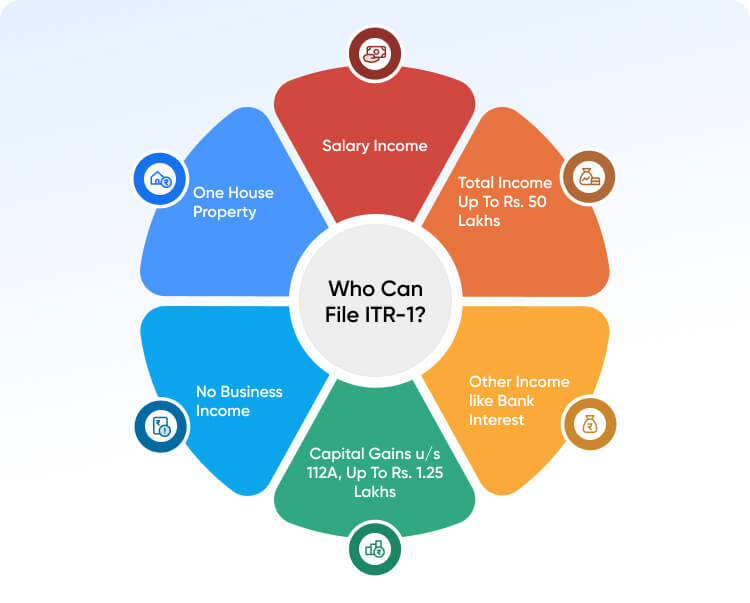ITR-1 Form (Sahaj) - What is ITR-1, Who Should File, Applicability and How to File ITR-1 for FY 2024-25 (AY 2025-26)
ITR 1, also known as Sahaj, is a simplified income tax return form for salaried individuals and pensioners earning up to Rs. 50 lakh. It is applicable if you have income from salary, one house property, and other sources like interest. This form is not meant for individuals with Short-Term Capital Gains, Long-Term Capital Gains exceeding Rs. 1.25 lakh, more than one house property, business income, or foreign assets.
ITR Due Date Extension 2025
The ITR due date has been extended to 16-09-2025, due to glitches in the Income Tax Portal.
What is ITR 1?
ITR 1, also known as the Sahaj Form, is an Income Tax Return form used by salaried individuals and pensioners with a total income of up to Rs. 50 lakh. It applies to taxpayers earning income from salary, one house property, and other sources like interest. This form is the simplest ITR and is ideal for individuals with straightforward income sources.
Download Form ITR 1 for AY 2025-26!
How Do I File my ITR 1 on ClearTax?
Step 1: Log in or sign up on the ClearTax portal.
Step 2: If you are filing with us for the first time, enter your PAN, Date of Birth, and the OTP received on your registered mobile number. Linking your PAN will help us file your return with the income tax department.
For us to pre-fill the details for you, you will have to complete another OTP verification. If you have filed with us before, you will directly see this step.
Once you enter the OTP and click on ‘Proceed’, you will see 90% of your information, like your name and income details, will all be pre-filled. You can review and edit these details if required.
Click on ‘verify OTP’.
Step 3: Now if you scroll down, you will find details of personal information, bank details, income sources, TDS deducted by your previous employers, taxes paid. At the end of the page, you will find an option to ‘upload your Form-16’.
You will land on Form-16 page. Here in ClearTax you can now upload multiple Form 16s if you have worked with more than one employer in the previous year.
You can upload your Form16 PDF provided by your employer or if you do not have Form16, then click on ‘Continue without Form 16’.
Note: Scroll down and you can upload multiple form 16s. Click on the option ‘ Upload Another’.
Step 4: Click on continue and you can see that all of your personal information is already filled under the ‘personal Info’ tab. Verify if the details provided are correct.
Step 5: Go to the income sources section, under the Salary Income, your salary details will be automatically filled as you have uploaded your Form 16. If there are any details missing, there is an option for you to manually fill the details as well.
Step 6: Under ITR 1 individuals having only one house property will be applicable, and hence if you have rental income from one house property then you can upload the details regarding the same under the ‘rental income’ section.
Click on ‘Add Details’ and you will be lead to a page where you have to enter details regarding the income that you receive from your rental property. Continue.
Step 7: Come back to the income sources page, and if you have income from other sources, select 'Interest income'.
Click on ‘Add Details’ and you can enter the details if you have interest income, income from deposits, interest earned from P2P transaction, interest from bond investments, PF interest, interest on income tax refund etc.
Step 8: With effect from the current tax season, long term capital gains under section 112A, up to Rs. 1.25 lakh can be reported using ITR-1. Therefore, you can import the capital gains directly from the broker or upload the capital gains statement directly in our product to add capital gain details.
Step 9: Now it's time to claim deductions, click on the 'Tax Savings' section. Click on ‘Add details’ and you can enter details regarding the deductions that you want to claim, TDS deducted and if any losses are carry forwarded or set off. Voila! you have now claimed all the eligible deductions.
Step 10: Click on ‘Go to next’ and your tax summary is as simple as that, here your gross income, taxable income, tax liability, tax refund and the type of ITR you are filing is displayed. Review all the details mentioned.
Also, the default tax regime for this year, according to the income tax department, is the New regime. However, the best part about filing your ITR with ClearTax is that it files your taxes under the regime that saves you maximum taxes by analysing your income and tax amount. You also have the option to compare your tax payable under both regimes and even switch to the other tax regime.
Once you are done reviewing all the details in the summary report, click on ‘File Tax’.
Step 11: Here, you will be asked to submit a self-declaration. Only once you submit this will your ITR be filed.
Step 12: Now, THIS is the final step. Click on the ‘submit return’ button. You will land on E-verification page, e-verify the return by entering the OTP received on your mobile number
Note: It is essential to remember that E-verification is a very important step in ITR filing, as this process completes the process.
Step 13: That’s it, and you are done with your ITR filing! But before you leave, don’t forget to collect these exciting rewards, cashback offers, and discounts. You have more than 20+ brands to choose from. If you have refund then it will be processed to your bank account within 30-50 working days after filing your income tax return.
Who is Eligible to File ITR 1 for FY 2024-25 (AY 2025-26)?

ITR 1 is a simplified Income Tax Return form for resident individuals with a total income of up to ₹50 lakh from the following sources:
- Salary or pension income (from one or multiple employers)
- Income from one house property (excluding cases with brought-forward losses)
- Income from other sources (excluding lottery winnings and racehorse income)
- Clubbed income of a spouse or minor child, only if their income falls under the same heads listed above
- Long-term capital gains (LTCG) up to Rs. 1.25 lakh, provided there are no brought-forward or carry-forward capital losses
Who Cannot File ITR 1 for AY 2025-26?
- An individual with an income above Rs 50 lakh.
- An individual who is either a director of a company or has
- Held any unlisted equity shares at any time during the financial year.
- Residents not ordinarily resident (RNOR) and non-residents.
- Individuals who have earned income through the following means:
- More than one house property
- Lottery, racehorses, legal gambling, etc.
- Taxable capital gains (short-term and long-term) other than Long-term capital gains income up to Rs. 1.25 lakhs
- Agricultural income exceeding Rs 5,000
- Business and profession
- A resident that has assets (including financial interest in any entity) outside India or is a signing authority in any account located outside India
- Individuals claiming relief of foreign tax paid or double taxation relief under section 90/90A/91
- Deferred income tax on ESOP received from an eligible start-up
- Gains from Virtual Digital Assets (Crypto currency)
- Individuals for whom TDS is deducted under section 194N
Last Date to File ITR 1 for FY 2024-25 (AY 2025-26)
The last date to file ITR 1 for FY 2024-25 is 16th September 2025 for taxpayers not required to conduct tax audit. The due date was extended from the initial due date of 31st July 2025, as there were major changes in the ITR 1 form for the year.
What are the Documents Needed to File ITR?
Documents which you need to file the ITR 1 form are:
- Form 16: Issued by all your employers for the given financial year
- Form 26AS: Remember to verify that the TDS mentioned in Form 16 matches the TDS in Part A of your Form 26AS
- Receipts: If you have not been able to submit proof of certain exemptions or deductions (such as HRA allowance or Section 80C or 80D deductions) to your employer on time, keep these receipts handy to claim them on your income tax return directly.
- PAN card
- Bank investment Certificates: Interest from bank account details – bank passbook or FD certificate
What is the Structure of the ITR 1 Form?
- Part A – General Information
- Part B – Gross total Income
- Part C – Deductions and taxable total income
- Part D – Computation of tax payable
- Part E – Other information (Bank account details)
- Schedule IT (Details of advance tax and self-assessment tax payments)
- Schedule-TDS (TDS/TCS details)
- Verification
Not sure which ITR form to use? Read our article on which ITR to file!
How to File ITR 1 (SAHAJ) Online on Income Tax Portal?
Step 1: Visit the Income Tax e-filing portal
Step 2: Register or Log in to your account
Step 3: Select e-file > Income Tax Returns > File Income Tax Return
Step 4: Select the Assessment Year as 2025-26 and the mode of filing as ‘Online’
Step 5: To start filing new, click on ‘Start New Filing’
Step 6: Select the applicable status, i.e. individual, HUF, and others
Step 7: Select ITR 1 as the form type
Step 8: Click on ‘Let’s Get Started’
Step 9: Select the appropriate reason and ‘continue’
Step 10: Now you will have to fill up 5 sections here
- Personal Information - This section requires you to provide basic details such as your full name, PAN and Aadhar number, contact information, and bank account details.
- Gross Total Income - includes all the income from all the sources you have earned income.
- Total Deductions - The Income Tax Act 1961 allows for various deductions under different sections, which you should claim accordingly. Commonly known sections for deductions include 80C, 80D, 80TTA, 80TTB, and others.
- Tax Paid - This section displays your tax payments from all sources, including TDS, TCS, Advance Tax, and Self-Assessment Tax.
- Total Tax Liability - In this section, you will find the computed tax liability based on the information provided in the previous sections. To clarify, the tax payable on the Total Income is calculated as (Income - deductions claimed - Tax paid till date). If the resulting amount is negative, it can be claimed as a refund. If it is positive, it needs to be paid as tax.
- Verification - This section includes all that the above mentioned details are verified by the assessee.
Step 11: Double-check to ensure the summary of tax computation is correct
Step 12: Rectify the errors, if any and complete the validation
Step 13: E-verify the ITR using Aadhaar OTP or EV
Major Changes Made in the ITR 1 Form from AY 2025-26
Inclusion of Long-Term Capital Gains (LTCG) Reporting:
Taxpayers can now report long-term capital gains (LTCG) under section 112A (from listed equity shares and equity-oriented mutual funds) in ITR 1, provided:
- The total LTCG does not exceed Rs. 1.25 lakh, and
- There are no brought-forward losses or losses to be carried forward under the capital gains head.
Previously, any capital gains required filing ITR-2; this change allows more taxpayers with a very less LTCG to use the simpler ITR 1 form.
Enhanced Deductions and Disclosures:
- Deductions under Sections 80C to 80U must now be selected from a drop-down menu in the e-filing portal, and the exact clause/sub-section must be specified. This aims to improve accuracy and transparency.
- Income from retirement accounts maintained abroad (Section 89A) has new fields for better relief tracking.
Aadhaar Enrollment ID Removed:
- The 28-digit Aadhaar Enrolment ID is no longer accepted.
- The field now only accepts valid 12-digit Aadhaar Numbers.
Additional Column under Schedule TDS:
- An additional column has been added under the Schedule - TDS Details to specify the section under which TDS is deducted.
Major Changes Made in the ITR 1 Form from AY 2024-25
- Individuals filing ITR 1 need to indicate their preferred tax regime in the return of income.
- The New Tax Regime is the default tax regime from this year, as per the amendments introduced by the Finance Act 2023 in Section 116BAC. For individuals, HUFs, AOPs, BOIs, and AJPs, the new tax regime will apply by default. However, those who prefer the old tax regime, they must explicitly choose to opt-out of Section 116BAC(6).
- For individuals with income (excluding income from a business or profession) need to specify their preferred tax regime in the income tax return filed for the relevant assessment year under Section 139(1).
For individuals with income from a business or profession, the option to opt out of the new tax regime and revert to the old tax regime is available. To exercise this choice, they must submit Form No. 10-IEA on or before the due date for filing the income tax return under Section 139(1). - An additional section, Section 80CCH, has been introduced by the Finance Act 2023. This section specifies that individuals who enroll in the Agnipath Scheme and subscribe to the Agniveer Corpus Fund on or after 01-11-2022 are entitled to a tax deduction for the entire amount deposited in the Agniveer Corpus Fund.
To accommodate this change, ITR form 1 has been updated to incorporate a new column which allows taxpayers to provide the relevant details regarding the amount eligible for deduction under Section 80CCH.
Not sure which ITR form to use? Read our article on which ITR to file!


